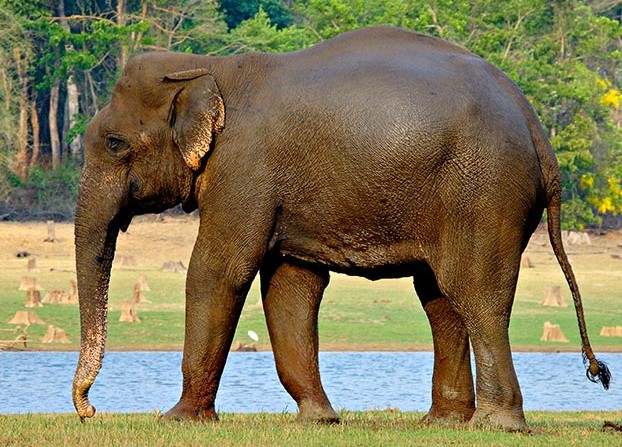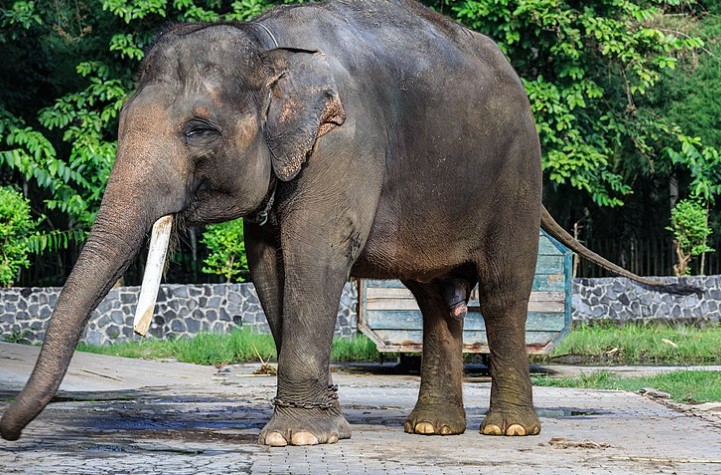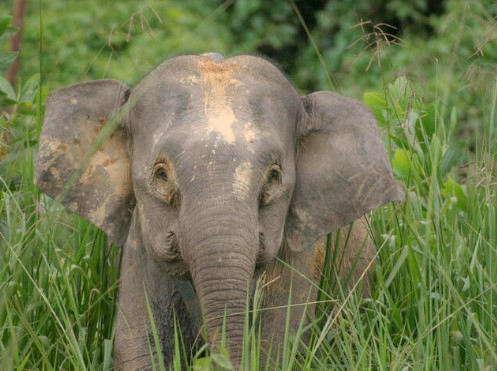











Elephants are the world’s largest land animals. They are found in Africa and Asia and have developed into two different species, the African elephant and the Asian elephant. Elephants have huge ears, long trunks, big bodies, pillar-like legs, and sharp tusks. The biggest elephant ever recorded weighed 24,000 pounds and was 13 feet tall at the shoulder.
Elephants have big bodies with four pillar-like legs. Their feet have a soft cushion which softens their steps, meaning they can walk quietly. Their skin looks tough but is very sensitive to insect bites and sunburn. Elephants have a trunk which is a combination of their nose and upper lip. Their trunk contains 40,000 muscles. Elephants use their trunks for breathing, smelling, drinking, eating, greeting one another, showering, and snorkeling. At the end of the trunk, there are two fingers for African and one finger for Asian. Elephants have two sharp tusks which are made of ivory. Elephants use their tusks for digging for water, digging up roots to eat, stripping bark off trees, defending their calves from predators like lions, and fighting for females. Elephants have big ears that they use to cool themselves on a really hot day. They also use their ears to swat away annoying bugs. Their tails are very short.
Elephants are very social animals that live in groups called herds. The herd consists of different females and their calves. The matriarch is the leader of the herd. She knows where to find water, where to find food, and where danger is. Male elephants stay with the herd when their calves. When they grow up, they leave the herd and spend most of their lives alone or with other males in a bachelor herd. Before bull elephants are ready to mate, they go through a stage called musth. That’s when high testosterone levels make their temporal gland secrete fluid that runs down the side of their head and can also make them more aggressive. Male elephants fight for females and the dominant one gets to mate with the female. Elephants are pregnant for 22 months before they give birth to a single calf.
Elephants are herbivores and feed mostly on plants and fruit. They are also known to knock down trees to get the leaves or strip the bark off them.
African elephants are larger than their Asian cousins. They have bigger ears that resemble the continent of Africa and have two fingers at the end of the trunk that they use to pick up a single fruit or leaf. Both males and females have tusks. They are found in Sub-Saharan Africa and live in grasslands, forests, and even deserts. It has two subspecies, the African savanna elephant(Loxodonta africana) and the African forest elephant(Loxodonta cyclotis).
African savanna elephants are the largest of the elephant species. They are found in Sub-Saharan Africa and live in grasslands and deserts. They mostly eat grasses and herbs. During the dry season, they eat tree bark. In the Kalahari, they had salt licks. In Kruger National Park, they ingested wood ash. According to the IUCN Red List, they are Endangered.
African forest elephants are the smallest of the elephant species and subspecies. They have straight tusks that point down. It is native to West Africa and the Congo Basin where it lives in dense forests. They mostly feed on tree bark, fruit, leaves, and seeds which they poop out to form new plants. It is considered Critically Endangered on the IUCN Red List.
Asian elephants are smaller than their African cousins. They have a dome-shaped forehead and smaller ears. Only the males have tusks. They have one finger on the end of their trunk which they use to wrap around their food. They are found in India, Sri Lanka, and Southeast Asia where they mostly live in tropical forests and scrublands. They have evolved into four subspecies, the Indian elephant(Elephas maximus indicus), the Sri Lankan elephant(Elephas maximus maximus), the Sumatran elephant(Elephas maximus sumatranus), and the Bornean pygmy elephant(Elephas maximus borneensis).
The Indian elephant is native to mainland Asia. It inhabits grasslands, dry deciduous, moist deciduous, evergreen, and semi-evergreen forests. They are both grazers and browsers. They graze on tall grasses and munch on bamboo shoots and clumps. They feed on the bark of the white thorn and munch on the fruits of wood apple, tamarind, kumbhi, and date palm. It is considered Endangered on the IUCN Red List.
The Sri Lankan elephant is native to Sri Lanka. They are widespread in north, south, east, north-western, north-central, and south-eastern Sri Lanka. They mostly ate shrubs, herbs, grasses, and vines. They are considered Endangered according to the IUCN Red List.
The Sumatran elephant is native to Sumatra. They reach a shoulder height of between 2 and 3.2 m and weigh between 2,000 and 4,000 kg. They are protected under Indonesian law. They are considered Critically Endangered under the IUCN Red List.
The Borneo pygmy elephant is native to northeastern Borneo. They are the smallest of the Asian elephant subspecies. They have long tails and straight tusks. They also have large ears relative to their size. They are considered Endangered on the IUCN Red List.
Elephants are threatened due to poaching, habitat loss, and human-wildlife conflict. Poaching is a threat to elephants around the world. Elephants are poached for their tusks which contain ivory and ivory poaching is a really big problem for elephants in Africa. Habitat loss is the biggest threat to all elephants. As their habitats are being destroyed, elephants are moving into human settlements which can lead to human-wildlife conflict. Farmers sometimes shoot elephants because they sometimes eat their crops. Many elephants can cause damage on the streets when they are mistreated in captivity.